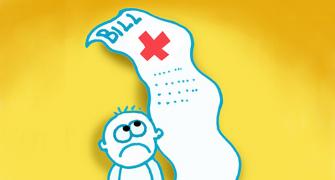Here's what borrowers must pay attention to before going in for such medical loans.
Tinesh Bhasin reports.

The rising cost of medical treatment could throw your finances out of gear if you don't have sufficient insurance.
To tap this market, a few non-banking finance companies (NBFCs) and financial technology (fintech) start-ups have started offering medical loans at a lower rate than personal loans.
Some even offer loans at zero per cent.
"Of the total personal loans we disburse, around 25 per cent are taken for treatment of medical illnesses. We, therefore, recently launched a separate medical loan category, in which the interest cost is lower," says Prithvi Chandrasekhar, head of risk and analytics, InCred.
Besides being underinsured, Chandrasekhar points out many also rely on their company's health insurance.
The sum insured in corporate plans varies, depending on the designation, and one could even have the co-pay option. That is, for a Rs 5 lakh medical cost, the individual may need to shell out Rs 1 lakh from his pocket.
Many of these lenders are able to lower the interest rate because the loans are disbursed directly to the hospital.
As the lender knows the end use, they consider it a slightly lower-risk product than a personal loan.
The borrower, however, needs to understand the structure of loans that come at zero per cent interest, as the lender can charge advance equated monthly instalments (EMI).
Will you lose hospital discounts?
Yes, you will. When a customer is funding treatment from his own pocket, hospitals are willing to offer discounts ranging from five to 30 per cent, according to experts.
But when a lender is involved, the hospital might not give you the discount or would lower it.
Many hospitals are also known to overcharge customers when the treatment is cashless, as in the case of insurance or when finance companies are directly paying the hospital.
Most lenders say they don't have control over this, but they tend to avoid partnering with hospitals known to inflate bills.
Different structures
If a company is giving a zero cost medical loan, it would mean the non-banking financial institution will pay the hospital a lower than disbursed amount.
The hospital or clinic, instead of giving you a discount, gives it directly to the lender.
For a Rs 1 lakh monthly reducing loan for one-year with an interest of 15 per cent, the total interest payout would be Rs 8,310.
Another model at work is that the lender takes one or two EMIs in advance.
It means, instead of getting Rs 1 lakh, the customer would get around Rs 90,974 if he pays one advance EMI.
"The structure varies, depending on the borrower's profile and the tie-up with the hospital," says Jose Peter, co-founder and chief executive officer, Arogya Finance.
Then, there's also a processing fee of one to three per cent.
Cheaper than personal loans
The medical loan typically differs from a personal loan on three parameters.
- It's given at a slight discount to personal loan rates
- The tenure for a medical loan on an average is 12 months; for personal loans, it's 36 months for most players.
- The average size of a medical loan is lower than a personal loan.
Most medical loan providers tie up with hospitals to offer loans. The interest rates vary with the arrangement the lender has with the hospitals.
"Our interest rate range is zero to 15 per cent depending on the partner hospital," says Peter.
The company also offers a card that has a pre-approved loan and up to five family members of the borrower can use it to pay at hospitals.
The interest rates are decided after the card is swiped. For InCred, the interest rates on a medical loan are the same as a personal loan: 11.5 to 24 per cent.
The same borrower will get a medical loan 2 to 3 per cent cheaper than a personal loan.
In the case of medical loans, there's also an urgency on the part of the lender to disburse the money.
The time of disbursement can be as quick as three hours and can take up to three days.
It varies depending on the 'quality of applicant's paperwork'.
Say, if the applicant's home address is the same as on the Aadhaar card, passport and in credit information bureau, the loan can be distributed faster.
Loans cover treatments that insurers don't
Some players have started offering no-cost EMI loans for treatments not covered by most health insurance plans.
Bajaj Finance, for example, offers no-cost EMI loans for treatment at specific clinics.
An individual can use it at partnering chains for dental procedures, in vitro fertilisation, eye care, stem cell treatment, hair restoration and slimming and wellness.
In Bajaj's Life Care Finance, too, a customer gets a pre-approved loan card that customers can swipe for payment of medical bills.
Qbera.com, an online personal loan platform, is planning to offer similar loans soon.
"Some institutions may view medical loans taken in emergencies as riskier as the borrower may not be able to work for some time after treatment. That's why some prefer to finance elective surgeries and treatments. In such cases, the clinics are also willing to bear the interest on the loan and customer gets a loan at zero cost," says Aditya Kumar, founder and CEO, Qbera.com.
The personal loan interest rate for Bajaj Finance is in the range of 14 to 18 per cent, whereas Qbera's rates range from 13.99 to 24 per cent, depending on the customer's profile.
Photograph: Kind courtesy Natanael Melchor/Unsplash










